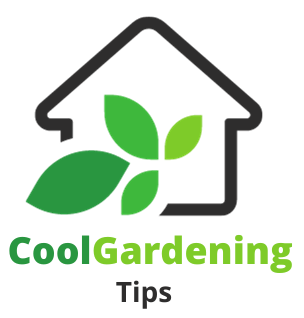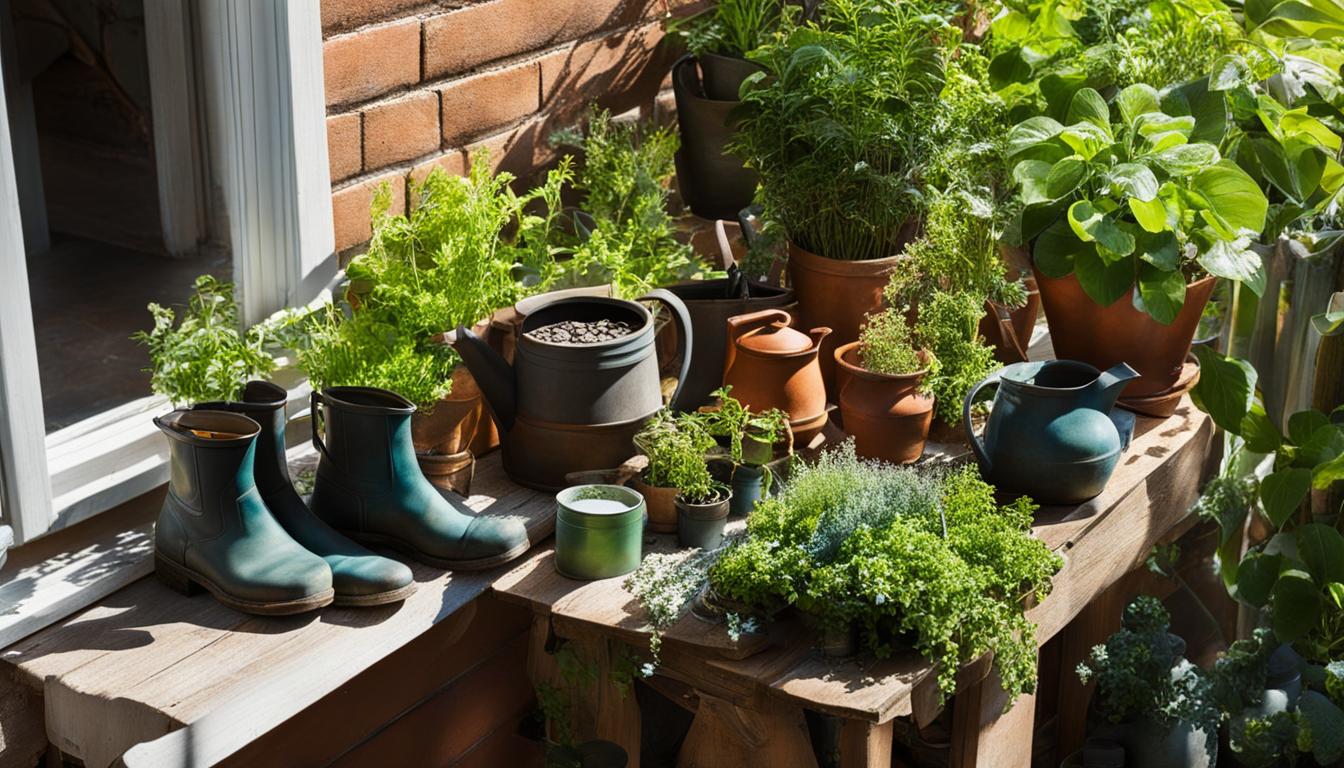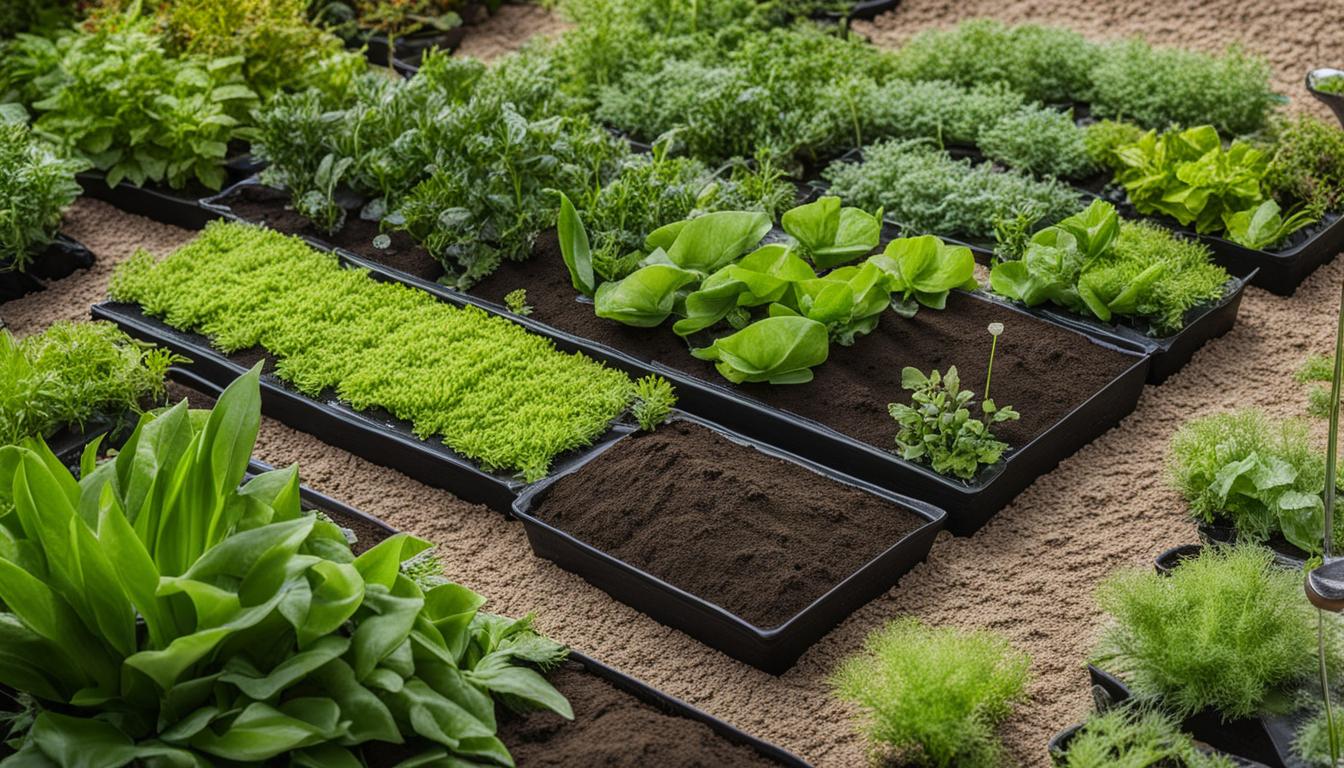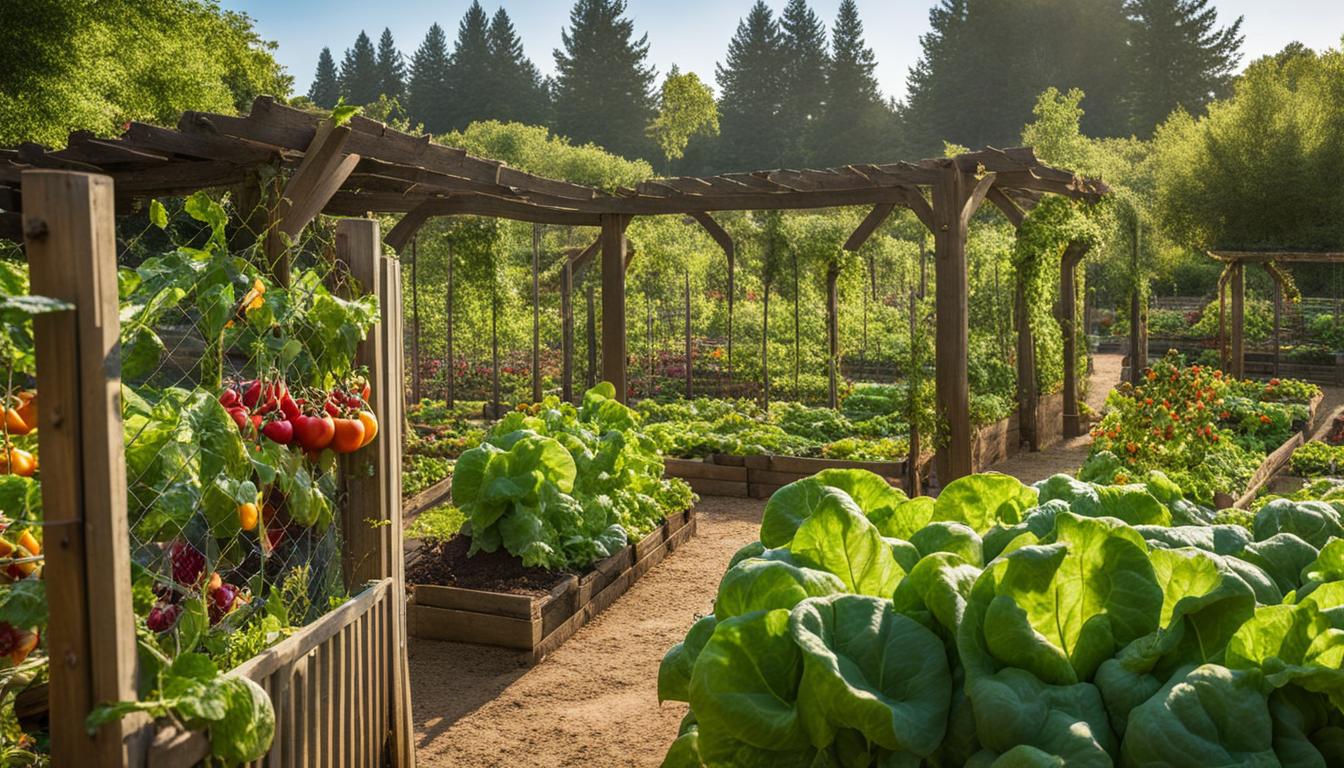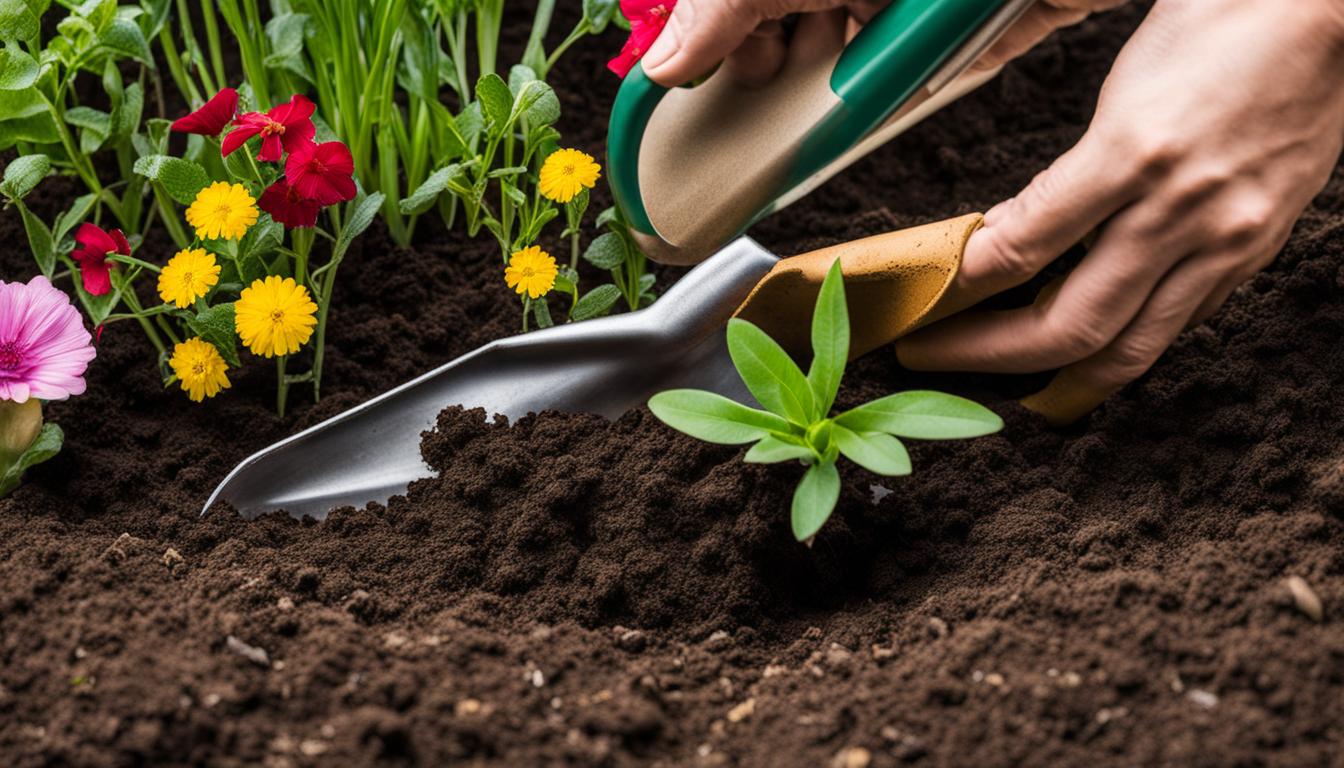Welcome to the wonderful world of container gardening! As an avid gardener, I can tell you that nothing beats the sense of satisfaction that comes from growing and harvesting your plants, right in the comfort of your home. Whether you have a spacious backyard or a small balcony, container gardening is a fantastic way to bring nature’s beauty and bounty to your doorstep.
In this section, I will share some essential tips for achieving container gardening success. By following these tips, you’ll be able to grow healthy, vibrant plants that will fill your home with color and fragrance. So, let’s dive in and explore some of the best tips for container gardening!
Container Gardening Basics
Welcome back! Now that you have a basic idea of container gardening, let’s dive into some fundamental techniques and ideas that can help you get started.
Selecting the Right Containers
The type of container you choose can have a significant impact on the success of your container garden. Whether you opt for terracotta, plastic, wood, or fabric containers, ensure the container is the correct size for the plant you intend to grow. Also, ensure that the container has proper drainage holes to allow excess water to drain away and prevent waterlogging that could cause root rot.
Choosing the Right Potting Soil
The potting soil you choose is also crucial in ensuring that your plants grow healthy and strong. Opt for a high-quality soil mix that is specifically designed for container gardening, as it allows for proper drainage, ventilation, and nutrition for your plants.
Ideal Location for Your Container Garden
Most plants require ample sunlight to grow, so ensure that you place your containers in a location that gets at least six hours of direct sunlight per day. Alternatively, if your location is prone to strong winds or harsh sun, consider placing your containers in a location with partial shade to protect your plants from damage.
Adding Verticality To Your Container Garden
Vertical gardening is an excellent option if you want to maximize your space, create visual interest, or have limited space. Try incorporating trellises, hanging baskets, or tiered planters into your container garden design, depending on the plants you intend to grow.
Containers can come in all shapes and sizes, so get creative and experiment with different materials and designs. Consider repurposing old household items, such as watering cans, teapots, or even boots, as unique and quirky planters, adding a touch of personality and style to your garden.
In the next section, we’ll discuss how to select the perfect plants for your container garden, ensuring that they thrive and yield bountiful harvests.
Selecting the Perfect Plants
When it comes to container gardening, selecting the perfect plants can be a challenging task. However, with some container gardening hacks and essential tips, you can choose plants that will thrive in your container garden.
One of the most important factors to consider is sunlight requirements. Some plants require full sun, while others thrive in partial shade. Therefore, it’s essential to choose plants that are compatible with the amount of sunlight that your container garden receives.
Another aspect to consider is plant size. In container gardening, space is limited, so it’s crucial to choose plants that won’t outgrow their containers. For example, small herbs like basil or thyme are ideal for small containers and are easy to care for.
Plant compatibility is also important to ensure that your plants will grow well together without competing for resources. For example, pairing fast-growing plants with slower-growing ones can result in an unbalanced container garden.
Finally, choosing the right potting soil is an essential factor that can make or break your container garden. Be sure to select high-quality potting soil that is specifically formulated for container gardening.
In summary, selecting the perfect plants for your container garden requires some container gardening hacks such as determining sunlight requirements, plant size, compatibility, and proper potting soil for best results.
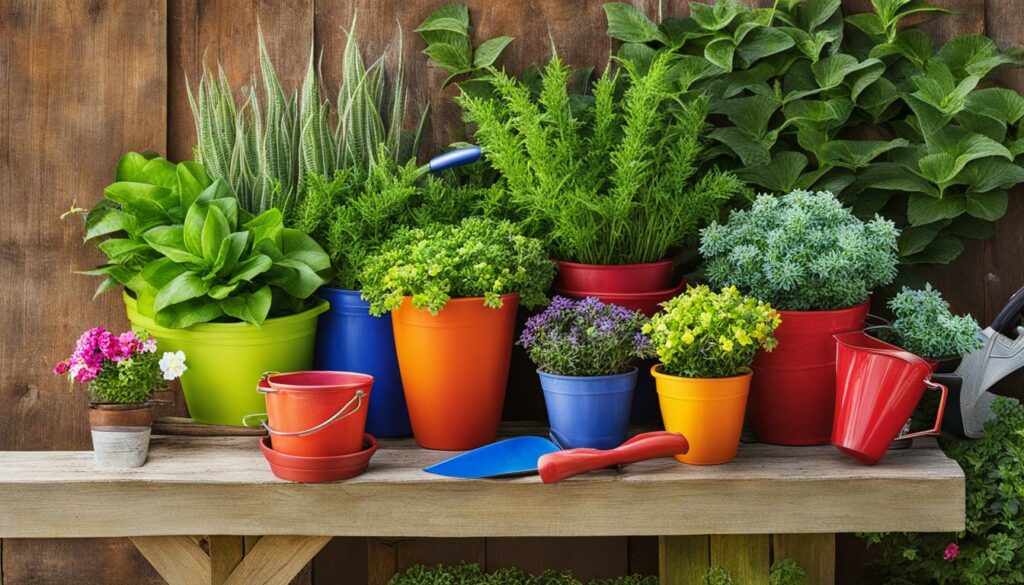
Proper Watering Techniques
Watering your container garden properly is essential for maintaining healthy plants. Here are some container gardening techniques and ideas to help you water your container garden effectively:
- Ensure adequate drainage: Before watering your container plants, make sure that the pots have sufficient drainage holes to allow excess water to escape. Without proper drainage, the roots can become waterlogged, leading to root rot and other issues.
- Water consistently: Container plants tend to dry out more quickly than plants in the ground, so it’s important to water them consistently to keep the soil evenly moist. Depending on the plant, you may need to water daily or every few days.
- Use the right amount of water: Overwatering can be just as damaging to plants as underwatering. Water your plants enough so that the soil is moist throughout the container, but not so much that water is pooling on the surface or draining from the bottom excessively.
- Check for signs of under or overwatering: Keep an eye on your plants for signs that they’re not receiving the proper amount of water. Wilting, yellow leaves, or stunted growth can indicate underwatering, while mold or fungus growth can indicate overwatering.
By following these container gardening techniques and ideas for proper watering, you can help your plants thrive and avoid common issues.
Feeding and Fertilizing
Feeding and fertilizing are essential aspects of container gardening. As the plants grow, they require more nutrients to thrive. In this section, I will discuss some container gardening hacks and essentials to help you provide the necessary nutrients to your plants.
The importance of fertilizing
Container plants rely on you to provide them with the nutrients they need to grow. Unlike plants in the ground, which can draw nutrients from the soil, container plants are confined to a limited amount of soil, and therefore, have less access to the necessary nutrients. Fertilizing helps to replenish the nutrients that are depleted over time, ensuring your plants get the nutrients they need to grow healthy and strong.
Types of fertilizers
There are several types of fertilizers available for container gardening. Organic fertilizers, such as compost and manure, are great for providing slow-release nutrients to the plants. They also help to improve the soil structure and drainage. Synthetic fertilizers, on the other hand, provide immediate nutrients to the plants and are available in different formulations for various types of plants.
When to fertilize
It is important to fertilize your container plants at the right time. Fertilizing too early can cause burning of the roots, while fertilizing too late can result in stunted growth. Generally, it is recommended to fertilize container plants every two to four weeks during the growing season, which is typically from spring to fall. During the dormant season, you can reduce fertilizing to once a month or stop altogether.
Application methods
There are different ways to apply fertilizers to your container plants. You can use granular fertilizers by sprinkling them on top of the soil and watering them in. Liquid fertilizers can be mixed with water and applied directly to the plants. My personal favorite is using slow-release fertilizers. These fertilizers can be applied just once or twice a year, and the nutrients are slowly released into the soil over time, providing a steady supply of nutrients to the plants.
Container gardening essentials
When it comes to fertilizing your container plants, here are some container gardening essentials to keep in mind:
- Read the fertilizer instructions carefully and follow them accordingly
- Avoid fertilizing your plants when the soil is dry
- Water your plants before and after fertilizing to prevent burning of the roots
- Use gloves when handling fertilizers to protect your skin
- Store fertilizers in a cool and dry place, away from children and pets
By following these tips and using the right fertilizers, you can provide your container plants with the necessary nutrients to grow healthy and strong.
Maintaining Healthy Soil
Maintaining healthy soil is essential for the success of any container garden. Unlike plants growing in the ground, container plants rely solely on the soil for their nutrients and water.
One of the most significant challenges in container gardening is soil compaction. Over time, the soil in containers can become compacted, restricting root growth, and reducing the plant’s ability to absorb nutrients and water.
To prevent soil compaction, it’s essential to amend the soil in your containers regularly. Adding organic matter such as compost, peat moss, or vermiculite can help improve drainage and prevent the soil from becoming too dense.
Another critical factor in maintaining healthy soil is ensuring adequate drainage. Poor drainage can lead to waterlogging, which can cause root rot and other soil-borne diseases.
Tip: To check if your container has adequate drainage, fill it with water and observe how quickly the water drains out. If it takes more than a few seconds, you may need to drill additional drainage holes or use a different container.
Additionally, it’s a good idea to refresh the potting soil in your containers every year. Over time, the soil can become depleted of nutrients, making it less effective in supporting plant growth.
Organic vs. Inorganic Soil
When it comes to choosing soil for your container garden, you have two options: organic or inorganic.
Organic soil is made up of natural materials such as peat moss, compost, and manure. It provides excellent drainage and is rich in nutrients, making it a popular choice for container gardening.
In contrast, inorganic soil is made up of synthetic materials such as perlite, vermiculite, and expanded clay. It is lightweight, provides excellent drainage, and is pH balanced.
Ultimately, the type of soil you choose will depend on your personal preference and the needs of your plants. Both organic and inorganic soil can be effective in container gardening, so it’s best to experiment and find what works best for you.

Managing Pests and Diseases
Dealing with pests and diseases is an essential part of maintaining a thriving container garden. Here are some container gardening hacks and essentials for managing pests and diseases:
Prevention
One of the best ways to manage plant pests and diseases is by preventing them from appearing in the first place. Here are some measures you can take:
- Choose healthy plants and avoid purchasing those with obvious signs of damage or disease.
- Clean your containers, tools, and hands regularly to reduce the risk of spreading pests or diseases.
- Practice crop rotation by changing the location of your plants every season to prevent the buildup of soil-borne pests and diseases.
- Keep an eye on your plants and act quickly if you spot any signs of trouble.
Identification
Being able to identify pests and diseases is crucial to managing them effectively. Some common issues you may encounter in container gardening include:
| Pest/Disease | Symptoms |
|---|---|
| Aphids | Stunted growth, yellowing leaves, distorted foliage, sticky residue on leaves. |
| Spider Mites | Fine webbing on leaves, yellow or brown spots on foliage, wilting leaves. |
| Powdery Mildew | White or gray powder on foliage, distorted growth, yellowing leaves, stunted plants. |
| Root Rot | Yellowing leaves, stunted growth, wilting plants, foul odor, soft or mushy roots. |
It’s important to note that these symptoms may also indicate other issues, so it’s best to confirm the diagnosis with a reputable source.
Treatment
Once you’ve identified the issue, you can take steps to treat it:
- Remove affected plant parts immediately.
- Treat with organic or chemical controls, depending on the severity of the issue.
- Apply preventative measures, such as neem oil or beneficial insects like ladybugs or praying mantises.
Always follow the instructions carefully and be patient, as some treatments may take time to be effective.
Managing pests and diseases in container gardening may seem daunting, but with these container gardening hacks and essentials, you’ll be well-equipped to keep your plants healthy and thriving.

Seasonal Care and Maintenance
Proper care and maintenance are essential for the success of your container garden. Each season requires specific attention and adjustments to ensure that your plants thrive throughout the year.
Spring
As the weather warms up, your container garden will require more water to accommodate the growth of new shoots and leaves. Regularly inspect your plants for signs of pests and diseases, and address any issues immediately.
Spring is also an ideal time to fertilize your container garden. Consider using a slow-release fertilizer to provide a steady supply of nutrients. You can also refresh the soil in your containers by adding fresh potting mix.
Summer
The hot summer months can present challenges for container gardening, as plants may require more frequent watering to combat the heat. Consider installing a drip irrigation system or using self-watering containers to help regulate moisture levels.
Regular deadheading of spent flowers can encourage new growth and extend the blooming period of your plants. Also, monitor your plants for signs of stress, including leaf drop and wilting, and adjust your watering schedule accordingly.
Fall
As temperatures begin to drop, it’s essential to protect your container plants from frost and freezing temperatures. Move sensitive plants indoors or to a sheltered area, and consider covering them with blankets or frost cloth.
Fall is also an ideal time to plant cool-season crops, such as lettuce, spinach, and kale. These plants can thrive in cooler temperatures and provide a fresh harvest throughout the fall and early winter.
Winter
In many regions, container gardening may not be possible during the winter months. If you live in a colder climate, move your containers to a sheltered area and wrap them in insulation, burlap or bubble wrap.
If you have limited space indoors, consider growing small herbs or citrus trees in a sunny window. These plants can provide fresh herbs and fruits throughout the winter season.
By following these seasonal care and maintenance tips, you can ensure that your container garden thrives year-round, producing a bountiful harvest and adding beauty to your home.

Creative Container Ideas
If you’re looking to add some visual interest to your container garden, there are plenty of creative container ideas to explore. These container gardening hacks can help you transform everyday items into unique vessels for your plants.
Repurposed Items
Turn old items into new planters! With a little creativity, you can repurpose almost anything into a container for your plants. Some ideas to try include:
- Teapots or coffee pots
- Old boots or shoes
- Wooden crates or pallets
- Wine barrels or whiskey barrels
Vertical Gardening Techniques
If you’re short on space, vertical gardening techniques can be a great container gardening hack. With vertical gardening, you can grow plants in a way that takes up less floor space and creates a stunning visual display. Some ideas to explore include:
- Wall-mounted planters
- Vertical planters made from pallets or PVC pipes
- Hanging baskets or planters
Unique Containers
For a truly one-of-a-kind container garden, try experimenting with unique containers. Not only will this make your container garden stand out, but it can also be a fun DIY project. Some ideas to try include:
- Old birdcages
- Garden fountains or statues
- Bicycles or wagons
- Light fixtures or lampshades
By thinking creatively about your container choices, you can take your container gardening to the next level. These container gardening essentials will help you create a beautiful and unique container garden that you can be proud of.
Troubleshooting Common Issues
If you’re experiencing yellowing leaves, wilting plants, or stunted growth in your container garden, don’t panic! These issues are common in container gardening and can be easily resolved with the right techniques.
Yellowing Leaves
If your plant’s leaves are turning yellow, it could be a sign of nutrient deficiency or overwatering. Ensure your container has proper drainage, and avoid overwatering by checking the soil moisture regularly. If the soil is too wet, allow it to dry out before watering again. Feed your plants with a balanced fertilizer to maintain soil health and provide essential nutrients.
Wilting Plants
Wilting plants are often a sign of under or overwatering. Check the soil moisture level and adjust your watering schedule accordingly. If the soil is too dry, give your plants a good soak. If it’s too wet, allow it to dry out before watering again. Provide shade for plants that require less sunlight, as wilting can also be a sign of sunburn.
Stunted Growth
Stunted growth can occur when plants are overcrowded or when the pot size is too small. Ensure your plants have enough space to grow and choose appropriately sized containers for each plant. If your plants are still struggling to grow, consider repotting them into larger containers with fresh potting soil.
By following these troubleshooting tips, you can ensure your container garden thrives and produces beautiful, healthy plants. Remember to always check your plants regularly, adjust your watering and feeding schedule, and provide the right growing conditions for each plant. With a little patience and the right techniques, you’ll be able to overcome any issues and enjoy a bountiful container garden.
Conclusion
Container gardening can be a fulfilling hobby that brings beauty, fresh produce, and a sense of accomplishment to your home. Through implementing the tips provided in this article, you can achieve successful container gardening even if you’re a beginner.
Remember to start with the basics, such as selecting the right containers, potting soil, and location for your plants. Choose plants that suit your needs, and provide them with proper watering and fertilization techniques. Don’t forget to maintain healthy soil and be vigilant in managing pests and diseases that may attack your plants.
Tips for Seasonal Care
Each season requires different care and maintenance tasks to keep your container garden thriving. In the winter, be sure to provide enough insulation to protect your plants from freezing. During the spring, focus on removing dead foliage and preparing the containers for new growth. In the summer, provide sufficient shade, and water regularly. In fall, remove dead plants and introduce cooler-weather varieties.
Creative Container Ideas
Get creative with your container garden by repurposing unique items such as old chairs, teapots, or even shoes. Utilize vertical gardening techniques to expand your garden vertically, saving space and adding aesthetic appeal. Plant herbs, flowers, or vegetables in the same container to create an exciting visual effect.
With the right techniques and creativity, container gardening can be a fun and rewarding experience. Start your container gardening journey today, and harvest the benefits of a flourishing home garden.
Keywords: successful container gardening, container gardening for beginners
FAQ
What is container gardening?
Container gardening is a method of growing plants in containers instead of traditional garden beds. It is an excellent option for those with limited space, as it allows you to create a garden on patios, balconies, or even indoors.
What are the benefits of container gardening?
Container gardening offers several benefits, including flexibility in terms of location, ease of maintenance, and the ability to control soil quality and drainage. It also allows you to experiment with different plant combinations and styles.
What types of containers can I use for container gardening?
You can use a wide variety of containers for your container garden, including pots, planters, hanging baskets, and even repurposed items such as buckets or cans. Just ensure that the containers have drainage holes to prevent waterlogging.
How do I choose the right plants for my container garden?
When selecting plants for your container garden, consider factors such as sunlight requirements, plant size, and compatibility with other plants. Choose plants that are suitable for the given container size and growing conditions.
How often should I water my container garden?
The frequency of watering depends on various factors such as plant type, container size, and environmental conditions. As a general rule, check the moisture level of the soil regularly and water when the top inch feels dry.
How do I prevent pests and diseases in my container garden?
To prevent pests and diseases, practice good sanitation by removing dead leaves or plant debris. Regularly inspect your plants for signs of pests or diseases and take appropriate action, such as using organic pest control methods or applying fungicides if necessary.
Can I grow vegetables and herbs in containers?
Absolutely! Many vegetables and herbs thrive in containers. Just ensure that you choose suitable varieties that are well-suited for container gardening and provide them with the necessary sunlight, water, and nutrients.
Do I need to fertilize my container plants?
Yes, container plants benefit from regular fertilization. Use a balanced, slow-release fertilizer or organic compost to provide the necessary nutrients for healthy plant growth. Follow the fertilizer manufacturer’s instructions for application guidelines.
How can I make my container garden more visually appealing?
Get creative with your container choices! Consider using unique containers, repurposed items, or even vertical gardening techniques to add visual interest to your container garden. Experiment with different colors, textures, and heights to create a visually appealing arrangement.
What should I do if my container plants are not thriving?
If your plants are not thriving, consider factors such as sunlight exposure, watering practices, and nutrient deficiencies. Adjust these variables accordingly and monitor the plant’s response. If issues persist, consult a local gardening expert for further guidance.
